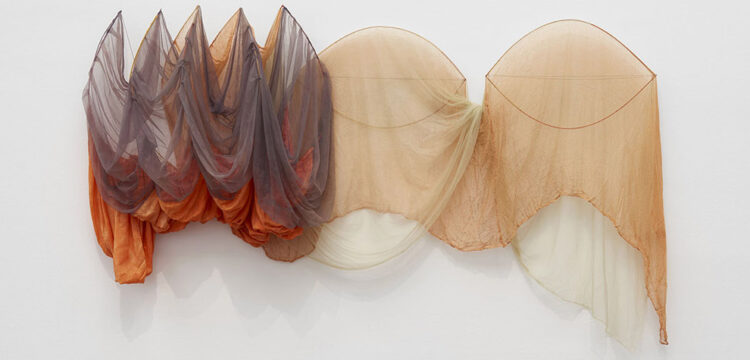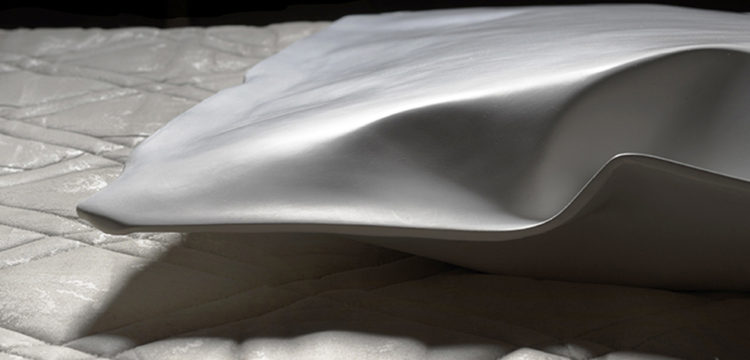The Evolutions of the Body and the Robe
From Sara Enrico to Loïe Fuller
This essay is an excerpt from the book The Jumpsuit Theme, which brings together works developed by Sara Enrico around the concept of the jumpsuit, in which its mutable skin becomes a sculptable casing, a malleable surface. It is the chosen site for a paradoxical, distorted recombining of bodies in a continuous evolution, driven by a social mechanism that transforms us, “turning us into the statues” of a present in decline, one in which each of us plays their part.
Loïe Fuller, an American dancer who left an indelible mark in the history of modern dance between the end of the nineteenth and early twentieth centuries, dwelt extensively on the creation of her most famous choreography, Serpentine Dance, in her memoirs. On her North American tour of the melodrama Quack, MD in 1891 in which she would mime the movements of a person under hypnosis, Fuller used a skirt of the finest Indian silk she’d been given years ago, which would become the mainstay of her costume. Her description of her performance of the hypnotized woman reveals the interaction between her body in motion and the movement of fabric, which would inspire Loïe Fuller’s entire conception of experimental dance: “My robe was so long that I was continually stepping upon it, and mechanically I held it up with both hands and raised my arms aloft, all the while that I continued to flit around the stage like a winged spirit. There was a sudden exclamation from the house: ‘It’s a butterfly! A butterfly!’ I turned on my steps, running from one end of the stage to the other, and a second exclamation followed: ‘It’s an orchid!’”
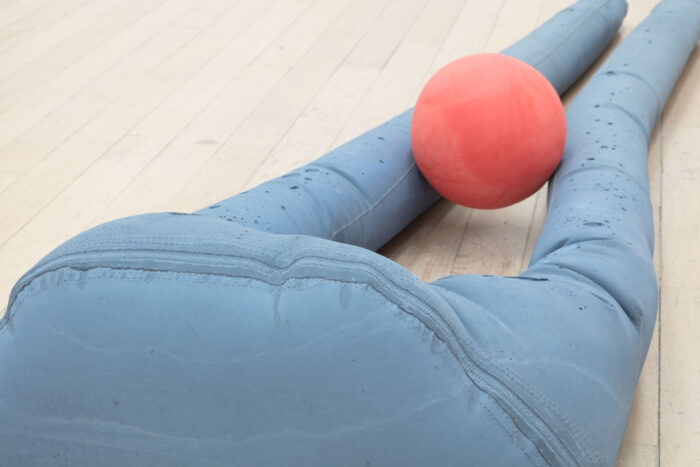
The significance of the fabric’s surface as the index of a three-dimensional form as well as the imprint of movement through space was the essential element of the revolution represented by Loïe Fuller. With very few movements, the dancer initiated motion that was mirrored by the cloth through the tension between the body and its drapery. The story of another dancer born in America was taking place in these same years, Isadora Duncan. Duncan inspired the models of clothing designed by Madeleine Vionnet, whose idea of sartorial cuts separated from the body and use of fabrics in simple geometrical form whose drape—more than anything else—would determine the shape of the garment worn is one of the primary cultural references Sara Enrico adopts in her work.
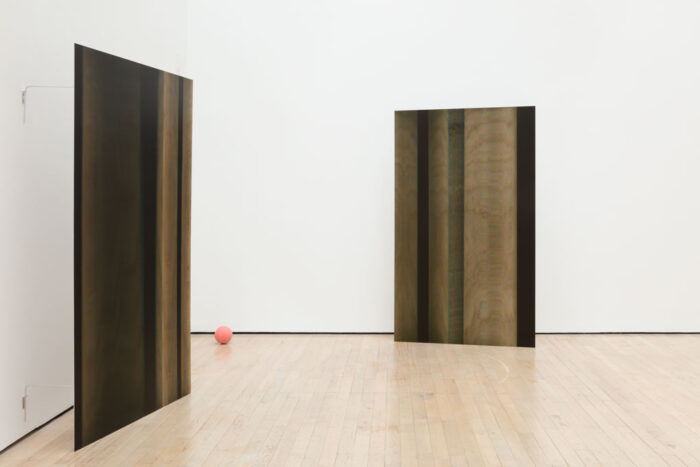
The trajectory of this lineage unfolds on multiple levels through the folds of Loïe Fuller’s robe. The relationship between the surface of fabric and the shape of body was, in fact, central to engender the movements that the dancer envisioned. Gazing at her body in the mirror wearing the Indian silk costume the day after receiving positive feedback about her performance as the hypnotized patient, Fuller experienced an authentic epiphany: “The mirror was placed just opposite the windows. The long yellow curtains were drawn and through them the sun shed into the room an amber light, which enveloped me completely and illuminated my gown, giving a translucent effect. Golden reflections played in the folds of the sparkling silk, and in this light my body was vaguely revealed in shadowy contour. This was a moment of intense emotion. Unconsciously I realized that I was in the presence of a great discovery, one which was destined to open the path which I have since followed. Gently, almost religiously, I set the silk in motion, and I saw that I had obtained undulations of a character heretofore unknown. I had created a new dance. […] Finally I reached a point where each movement of the body was expressed in the folds of silk, in a play of colors in the draperies that could be mathematically and systematically calculated. The length and size of my silk skirt would constrain me to repeat the same motion several times as a means of giving this motion its special and distinctive aim. I obtained a spiral effect by holding my arms aloft while I kept whirling, to right and then to left, and I continued this movement until the spiral design was established. Head, hands and feet followed the evolutions of the body and the robe.”

Body and fabric were taken as a whole in developing the sequence of movements comprising Serpentine Dance. In the body-fabric combination, light was essential in the authentically cinematic construction of the performance. Investigated through specific sources of inspiration, the surface has always been the common theme connecting Fuller’s inventions to the three-dimensional works of The Jumpsuit Theme and the latest prints by Sara Enrico entitled Intermezzo. Noticing and building upon the effects of shadow and transparency of the fabric as opposed to the curtains on the window and the mirror reflection of the skirt, Fuller developed the idea of the movements of her dance. The movement of her dress, rather than the one of the body, determined the gestures and steps (due to the excessive length of the gown, Loïe Fuller would have to raise her arms, assuming the form of a winged creature): in her published memoirs, the correspondence of the action that “set the silk in motion” with the discovery of “undulations of a character heretofore unknown” and even more so, the precedence in time and logic of the former over the latter attest to the centrality of the surface of the fabric in engendering the imagination. Further to the point, the connection between the emotion that filled the dancer upon the first inkling of this discovery, the memory of the past and the state of “reverie” suddenly induced by the contact with the skirt in Indian silk would allow to investigate the power of the (e)motion engendered by the surface and the modes of perception on which this haptic reaction of contact is rooted, but such an analysis would require more attention than can be applied here.

The multiple artistic practices and the various media traversed in the development of Sara Enrico’s work, the different cultural and artistic references evoked, the apparent contradiction between a nearly “choreographic” sense of movement and the actual static nature of the works are reconciled in the surfaces of her works. Enrico’s approach seems to be meant to investigate the surface in depth, beyond the literal meaning of the word, in order to reveal its authentic textural value. Her works compose an articulate reflection on the “surface of design” as conceived by the French philosopher Jacques Rancière. Opposing to Clement Greenberg’s “medium specificity”, for Rancière the surface as configuration of “types”—be they images, lines, or words on a two-dimensional plane or in space—is the mediator between the forms of art, languages and media, which is the distinctive signature of modernity. Significantly, the figure of Loïe Fuller and her choreographies represent the subject of investigation through which Rancière develops his concept of “the surface of design” and succeeds in explaining the meaning of “type” in modern artistic production: “Loïe Fuller does not trace figures with her feet. She remains static. She dances with her dress, which she unfolds and refolds, making herself a fountain, a flame or a butterfly.” The graphic preciseness of the positions assumed by the dancer, the sculptural values of her choreography, and the contribution of lighting effects to the creation of the figure all worked together to make her an icon that was subsequently used for the most diverse purposes. Fuller’s image was used in posters advertising Odol mouthwash, where the letters in the German company’s name were treated as if they were objects in their own right in dialogue with the forms of the dancer’s movement. Rancière mentions and describes these posters to explain the significance of design as the model of a particular form of mimicry in modern art, the mimicry of genres and forms: “By drawing lines, arranging words or distributing surfaces, one also designs divisions of communal space. It is the way in which, by assembling words or forms, people define not merely various forms of art, but certain configurations of what can be seen and what can be thought, certain forms of inhabiting the material world. These configurations, which are at once symbolic and material, cross the boundaries between arts, genres and epochs. They cut across the categories of an autonomous history of technique, art or politics.”

All this happens in the space of a surface, whether a poster, sheet of paper or fabric, and it is vis-à-vis this interpretation, I believe, that the many forms of Sara Enrico’s work reunite in a consistent vision. The dynamic implications of alternately folding and unfolding, coiling and uncoiling are evident in the descriptions of Loïe Fuller’s movements and the interpretations given to them. These observations lead to the emergence of a theme that is fundamental to the theoric debate on what a surface is, and more in general, what modernity is: the fold. The pigment prints Enrico made by moving an oak wood filler over the plate of a scanner and an oak wood fillet reveal the deeper meaning of the fold as the configuration of movement in space, and ultimately, relationship. The curves created in these works are as visible as they are virtual; only the image is capable of enclosing in a single form the geometric principle of the object and the movement that has acted upon it. In this sense, surfaces caught in the unceasing motion of folding and unfolding evoke the principle, as philosophical as it is visual, of the “inflection” on which Gilles Deleuze bases his analysis of the fold and the baroque spirit of modernity. Inflection as curvature and as movement in both time and space includes subject and object in a motion that can be described in the forms of the bundling of a bolt of fabric or cloth. “Texture”, for Deleuze, is the material given of reality without which no fold is possible. Not an assembly of characteristics, it is an interwoven stratification of levels of material and experience. It is a superimposition of layers, or rather surfaces, that only the movement of the fold can reveal and reconnect to a higher principle of harmony: “Tout se plie à sa manière, la corde et le bâton, mais aussi les couleurs qui se répartissent d’après la concavité et la convexité du rayon lumineux, et les sons […]. La texture ainsi ne dépend pas des parties elles-mêmes, mais des strates qui en déterminent la ‘cohésion’: le nouveau statut de l’objet, l’objectile, est inséparable des différentes strates qui se dilatent, comme autant d’occasions de détours et de replis. Par rapport aux plis dont elle est capable, la matière devient matière d’expression. […] Actives ou passives, les forces dérivatives de la matière renvoient à des forces primitives qui sont celles de l’âme. Toujours les deux étages, et leur harmonie, leur harmonisation.”
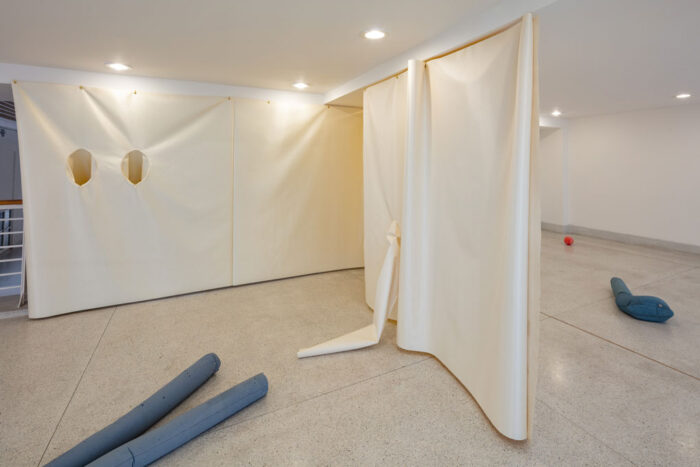
In different media and different forms, Sara Enrico’s works seem to represent the edge, the extreme extent at which the relationship between the forces acting on a material and its state of resistance brings to light the texture of the surfaces, be they real or virtual, physical or spiritual.




